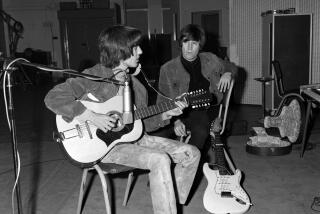Theodore McCarty; Key Figure in Electric Guitarâs Development
Theodore M. âTedâ McCarty, who as president of the Gibson Guitar Co. played a pivotal role in the development of the electric guitar, has died.
McCarty died April 1 in Twin Falls, Idaho, at the age of 91.
A native of Somerset, Ky., the future guitar builder was educated at the University of Cincinnati and graduated with a degree in commercial engineering. During World War II, he was an engineering designer for the Army.
After the war, McCarty found work in sales. He ran the retail chain of the Wurlitzer Co. before leaving to join the Gibson Guitar Co. in 1948.
The Kalamazoo, Mich.-based firm was losing tens of thousands of dollars a month when McCarty came aboard as general manager. But two years later he was named president of the firm and within a few months the company was running in the black. By the time he left in 1966, Gibsonâs staff had grown from 150 to 1,200, and production had increased from 5,000 instruments a year to a 1965 peak of 100,000. At the height of the guitar boom there was a two-year back order on some of the firmâs more popular models.
The firmâs turnaround was partly because of McCartyâs strong business acumen and partly because of the folk boom of the late 1950s and â60s, along with the popularity of rock stars such as Elvis Presley and the Beatles.
For his part, McCarty understood the importance to the market of the electric guitar. In 1952, he introduced the solid-body Les Paul model, endorsed and partially designed by Paul, who had been pressing McCartyâs predecessor at Gibson to develop the electric instrument. The model allowed Gibson to compete with Leo Fenderâs solid-body Telecaster guitar.
The sunburst finish variant of the Paul model guitar, produced from 1958 to 1960, has since become an extremely popular model with collectors. An original sunburst Les Paul, priced at $249, now commands tens of thousands at auction.
McCarty and his team of designers also introduced the rocket-like Flying V; the ES-175, which was the instrument of choice for many jazz guitarists; and the Firebird, a guitar shaped by Detroit car designer Ray Dietrich. And while some of these models didnât sell well at first, they eventually became high-priced collectorsâ items.
Other innovations during the McCarty era included the Gibson humbucking pickup, introduced in 1957, which amplified the guitar sound without picking up extraneous noise.
According to Jim Washburn, author and guitar expert, âan unanticipated feature of the pickup was the way it could be driven into distortion, which is a quality first used by blues musicians and since used to create the grind of heavy metal music.â
In 1966, McCarty left Gibson to buy the Bigsby Co., which manufactures vibratos for guitars. He sold the company and retired in 1999.
Throughout his later years, he was a popular figure at guitar trade shows, many of which he started, offering details on the development of various guitars and accessories.
Some years ago, the prominent guitar builder Paul Reed Smith recognized McCartyâs accomplishments by naming a guitar model in his honor.
McCarty is survived by a daughter, Sue Davis of Twin Falls; a son, Theodore F. McCarty of Harbor Springs, Mich.; four grandchildren; and six great-grandchildren.
